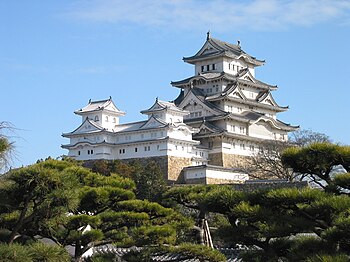
Back Liste der Nationalschätze Japans (Burgen) German Liste des Trésors nationaux du Japon (châteaux) French Daftar Pusaka Nasional Jepang (puri) ID Danh sách bảo vật quốc gia Nhật Bản (tòa thành) Vietnamese 日本国宝城郭列表 Chinese

The Japanese Sengoku period from the mid-15th to early 17th century was a time of nearly continual military conflict. Powerful military lords known as daimyōs, such as Oda Nobunaga, Toyotomi Hideyoshi or Tokugawa Ieyasu, struggled to unify Japan.[2] During the Sengoku period, because of constant warfare, many fortifications and castles were built. Archetypal Japanese castle construction is a product of the Momoyama period and early Edo period.[2]
A new era of castle construction began when the daimyo Nobunaga built Azuchi Castle from 1576 to 1579.[3] Earlier fortifications of the Kamakura and Muromachi periods were crude large-scale structures; Azuchi, however, with rich ornamentation and a keep rising seven stories high, became the prototype for castle construction of the period.[4][5] The style of Azuchi Castle marked a shift in the function of the castles from a place that was merely a fortress and military garrison to a political, cultural and economic center. The newer style castles functioned as home to the daimyōs, his family, and his most loyal retainers. Because of the expense of building such a lavish structure, castles in the style of Azuchi, functioned also to highlight the power and prestige of the daimyōs.[2][6] These new castles were built of wood and plaster on a stone foundation. Generally the main keep or tenshu was positioned at the highest point, surrounded by a series of interlocking baileys with walls, small towers and pathways.[7] Residential buildings were located in one of the outer circles. The daimyō conducted his business in the citadel.[8]
Almost 100 major castles were built between 1596 and 1615.[5] The peak of castle-building occurred during the years 1600 to 1615: in 1600 Tokugawa Ieyasu defeated the Toyotomi clan in the Battle of Sekigahara; and in 1615 the Toyotomi forces were finally destroyed in the siege of Osaka.[2][9] The Tokugawa shogunate then limited the number of castles to one per province; and banned the building of new castles entirely in 1620.[2][9] By the time of the Meiji Restoration in the late 19th century, castles were in a state of disuse and neglect. Seen as symbolic of the ruling elite of previous eras, some castles were dismantled and sold as firewood. Others were destroyed by fire, earthquake or typhoon. Only twelve castles have a donjon that is considered original.[4]
The term "National Treasure" has been used in Japan to denote cultural properties since 1897.[10] The definition and the criteria have changed since the inception of the term. These castle structures adhere to the current definition, and were designated national treasures when the Law for the Protection of Cultural Properties was implemented on June 9, 1951. The items are selected by the Ministry of Education, Culture, Sports, Science and Technology based on their "especially high historical or artistic value".[11][12] This list presents fifteen entries of National Treasures from six castles built during the late Momoyama to early Edo period; however, the number of structures is actually more because in some cases multiple structures have been combined to form a single entry.[nb 1][nb 2] The structures listed include donjon, watch towers, goten (castle palace) [13] and connecting galleries.[12]
- ^ Turnbull & Dennis 2003, p. 52
- ^ a b c d e Deal 2007, p. 315
- ^ Coaldrake 1996, p. 104
- ^ a b Nishi & Hozumi 1996, p. 93
- ^ a b Coaldrake 1996, p. 106
- ^ Coaldrake 1996, pp. 105–106
- ^ Turnbull & Dennis 2003, p. 21
- ^ Deal 2007, p. 318
- ^ a b Coaldrake 1996, p. 105
- ^ Coaldrake 1996, p. 248
- ^ "Cultural Properties for Future Generations" (PDF). Tokyo, Japan: Agency for Cultural Affairs, Cultural Properties Department. March 2017. Archived from the original (PDF) on 2017-12-16. Retrieved 2017-12-17.
- ^ a b 国指定文化財 データベース [Database of National Cultural Properties] (in Japanese). Agency for Cultural Affairs. Archived from the original on 2017-05-02. Retrieved 2017-12-17.
- ^ https://nijo-jocastle.city.kyoto.lg.jp/introduction/highlights/ninomaru/?lang=en
Cite error: There are <ref group=nb> tags on this page, but the references will not show without a {{reflist|group=nb}} template (see the help page).
© MMXXIII Rich X Search. We shall prevail. All rights reserved. Rich X Search